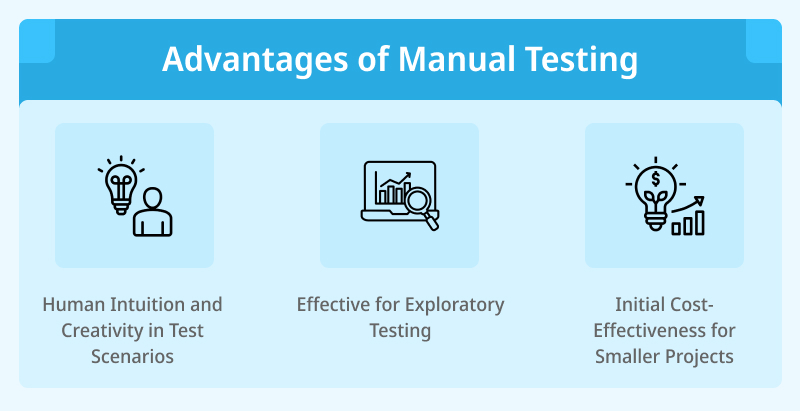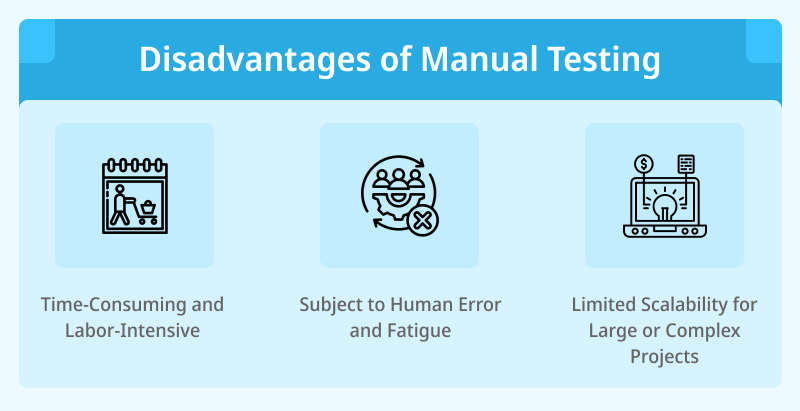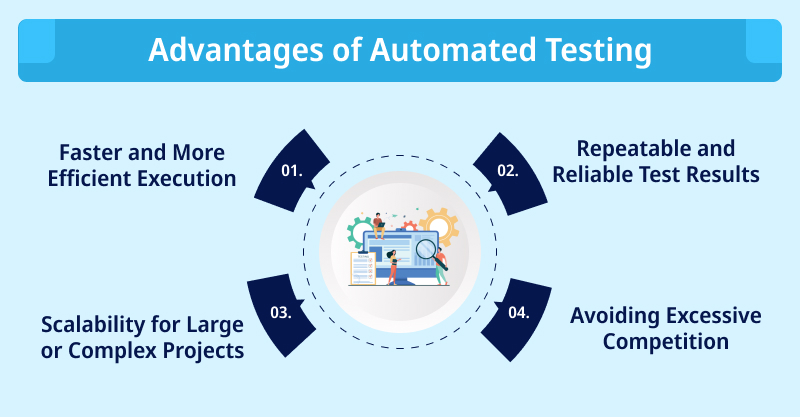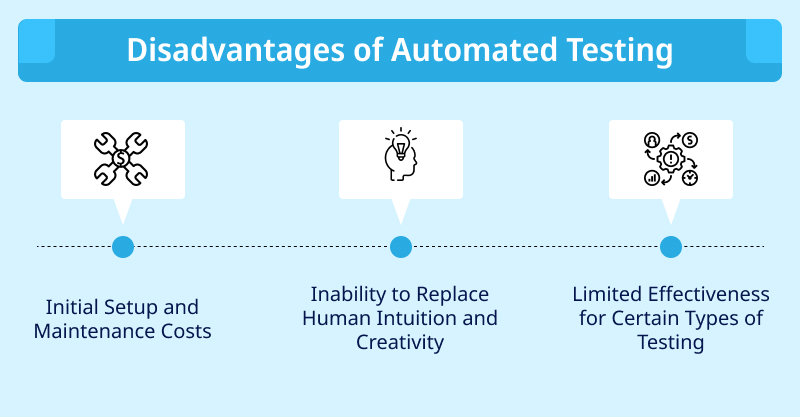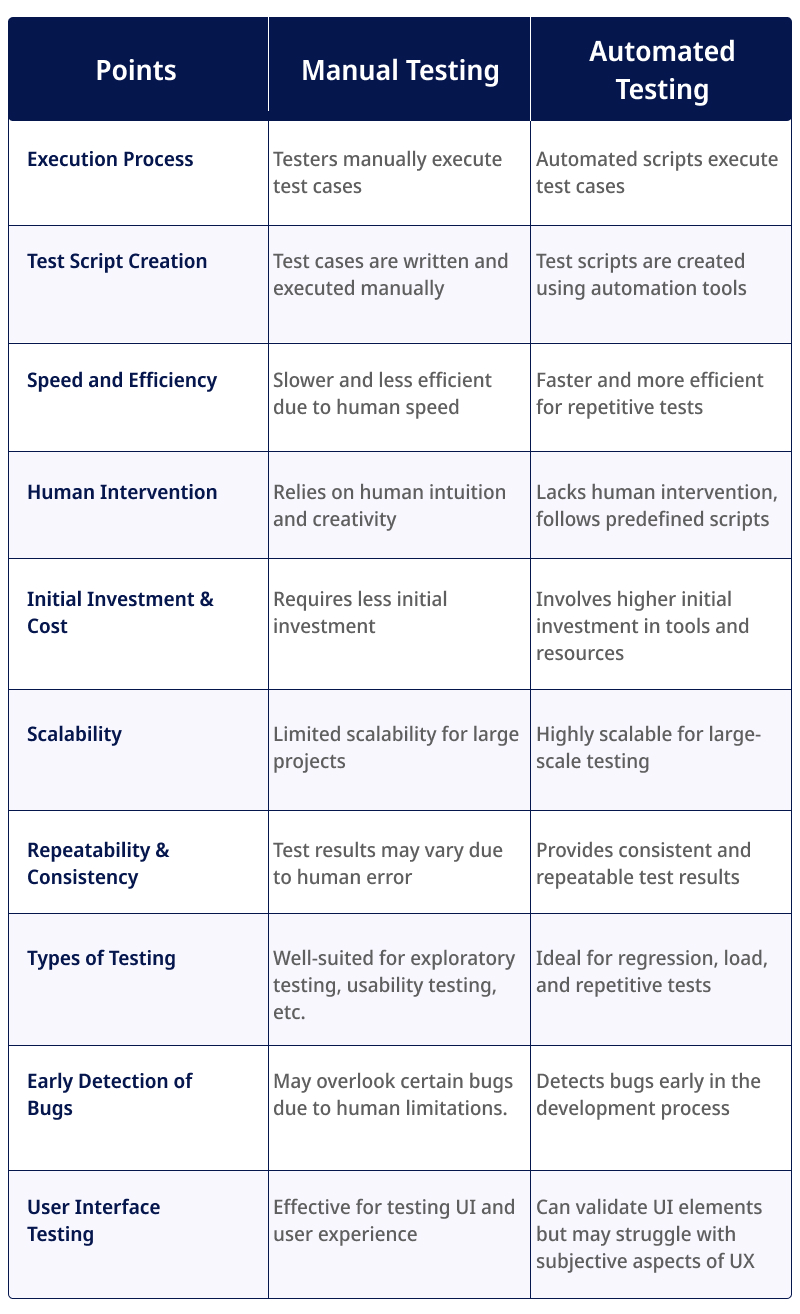In software development, testing plays a critical role in ensuring the delivery of high-quality products. However, businesses often need help choosing between manual and automated testing approaches. Manual testing demands human effort, time, and meticulous attention as testers execute test cases to identify defects and ensure the software’s functionality.
On the other hand, automated testing promises efficiency and repeatability, with test scripts running automatically to validate software functionalities. The struggle to strike the perfect balance between the two can be daunting for many organizations as they seek to optimize testing efforts, achieve thorough test coverage, and deliver a flawless user experience.
Finding the right mix of manual and automated testing best suited to the project’s needs and constraints is essential for a successful testing strategy. In this blog, we’ll delve into manual vs. automated testing, uncovering their respective pros and cons.
Table of Contents
Manual Testing
In manual testing, human testers execute test cases without using automation tools. It involves hands-on testing and relies on the testers’ observation, intuition, and creativity to validate the functionality and quality of the software.
Additionally, manual testing allows testers to explore various test scenarios and uncover defects that automated tests might miss. This is particularly effective for exploratory testing and scenarios where constant changes in requirements or user experience evaluations are essential.
Pros of Manual Testing
The human element might be crucial when it comes to software testing. The traditional manual testing method has several benefits since it uses the special abilities of human testers. Let’s examine these benefits in more detail:
- Human Intuition and Creativity in Test Scenarios: One of its key benefits is the human aspect that manual testing adds to the testing process. Intuition and critical thinking skills enable skilled testers to imagine numerous test scenarios that automated tests could overlook. Using their domain knowledge and expertise, they can replicate user interactions and spot problems that automated scripts might miss. Testing complicated or cutting-edge software features, where test cases are difficult to predict, benefits significantly from this ingenuity.
- Effective for Exploratory Testing: Exploratory testing is an ad-hoc, unscripted testing method where testers actively explore the application without using pre-written test cases. It is especially well suited for exploratory testing as manual testing allows testers to adjust and react to real-time feedback. It is useful for identifying hidden flaws and usability problems since testers can look into unexpected behavior, experiment with various input combinations, and improvise test scenarios based on their observations. Exploratory testing is a crucial step in the testing process since it frequently generates fresh test concepts and insightful information.
- Initial Cost-Effectiveness for Smaller Projects: Manual testing might be economical when working on smaller projects with tighter budgets and schedules. It has lower setup costs than automated testing, necessitating a sizable upfront investment in automation technologies, framework development, and upkeep. The high upfront expenses of automation may not be justifiable for smaller projects, making manual testing a sensible alternative. Additionally, because manual testing depends on tester expertise rather than sophisticated technical setups, it’s simple to start. This cost-effectiveness is advantageous when the project’s scope doesn’t warrant a comprehensive automated testing effort.
Cons of Manual Testing
While manual testing has advantages, it also has cons that may limit how efficient and successful it is in specific situations.
- Time-Consuming and Labor-Intensive: Manual testing can be labor-intensive and time-consuming, particularly when working with extensive or sophisticated software applications. Testers must adequately carry out each test case, who must document the results, and note any problems. This might take a lot of time and work. The testing workload grows proportionally as the application’s size and complexity grow, which could cause project delays.
- Subject to Human Error and Fatigue: Manual testing depends on human testers, making it prone to human errors and fatigue. Only intentionally, testers may notice flaws, interpret requirements correctly, or record incorrect results. Additionally, extended testing sessions might cause tester tiredness, affecting their accuracy and attention to detail.
- Limited Scalability for Large or Complex Projects: Manual testing becomes less scalable as the scope and complexity of the project rise. It becomes difficult for a small team of testers to handle the burden when there are many test cases to complete. This restriction makes it difficult to get thorough test coverage and may leave important application components untested.
Automated Testing
Automation testing is a technique that uses specialized automated testing software tools to execute a test case suite. The test stages are meticulously carried out by a human performing manual testing while seated in front of a computer.
The automation testing software may generate thorough test reports, compare expected and actual findings, and enter test data into the System Under Test. Software test automation necessitates significant financial and material inputs.
Explore the benefits of automated testing and how it can streamline your software testing processes.
Pros of Automated Testing
Automated testing has become a potent solution with many benefits that greatly aid in accomplishing software development projects. Let’s examine the principal benefits of automated testing:
- Faster and More Efficient Execution: The speed and effectiveness of automated testing is one of its biggest benefits. Many test cases can be quickly executed by automated test scripts in a small portion of the time required for manual execution. This quick execution offers quicker feedback, speeds up the testing procedure, and shortens the development cycle as a whole.
- Repeatable and Reliable Test Results: Test results that are consistent and repeatable are produced by automated tests that adhere to preset scripts and instructions. Automated testing ensures dependable results every time the tests are run, enhancing trust in the correctness of the testing process, in contrast to manual testing, which can be subject to human errors and variations.
- Scalability for Large or Complex Projects: Manual testing gets more difficult and time-consuming as software projects get bigger and more complicated. On the other side, automated testing can easily handle extensive test libraries and intricate situations. Teams can effectively manage regression tests with automated testing, execute tests across several environments, and guarantee the application’s stability as it develops.
- Cost-Effectiveness in the Long Term: While deploying automated testing may necessitate an initial investment in automation technologies and knowledge, it ultimately turns out to be cost-effective. The total development cycle shortens as the testing process becomes quicker and more effective, decreasing time to market and saving money on manual testing efforts. Automated tests are also more cost-effective because they may be applied to software iterations and versions.
Cons of Automated Testing
Automated testing has become an essential component of the software development process due to its ability to automate repetitive operations and increase testing effectiveness. However, it also has some drawbacks. Let’s look into the negative aspects of automated testing.
- Initial Setup and Maintenance Expenses: Automated testing implementation necessitates a large initial investment in tools, frameworks, and qualified automation engineers. Choosing the right testing tools, incorporating them into the development process, and creating reliable test scripts are all part of the setup step. Additionally, as the application changes, the continued maintenance of these scripts necessitates frequent modifications. These expenses could be prohibitive, especially for startups and small firms with little funding.
- Inability to Replace Human Intuition and Creativity: Automated testing lacks the human touch that comes with manual testing and cannot take the role of human intuition and creativity. The intuition and inventiveness of testers enable them to venture into unexplored territory and use creative test scenarios. While automated tests excel at repetitive activities and validating established scenarios, they could miss unforeseen flaws that exploratory testing by human testers might pick up.
- Limited Effectiveness for Some Testing Types: While automated testing excels at regression and functional testing, it may not be appropriate for other testing types. For instance, human judgment is needed to analyze subjective elements in usability testing, where testers rate the user experience. Additionally, manual testing is more effective at addressing testing elements like visual design, aesthetics, and user emotions.
Also Read: Automation in Software Development- A New Stream of Revolution
Manual Testing vs Automated Testing: Choosing The Right Mix
In software testing, choosing between manual vs. automated testing is a crucial decision that can significantly impact the effectiveness and efficiency of the testing process. Both approaches have distinct characteristics and cater to different testing needs.
Let’s explore the difference between manual and automation testing to understand when and how to strike the right balance:
-
Execution Process
Manual Testing: Testers manually carry out test cases without using automated testing software. They validate the product’s functionality by executing multiple test scenarios, watching the program’s behavior, and reporting bugs based on their findings.
Automated Testing: Test cases through automated testing tools and scripts. The testing tool automatically executes the test scripts after they are prepared, comparing the results to what was anticipated.
-
Test Script Creation
Manual Testing: Testers create and carry out test cases manually with test plans and scripts. In every stage of the testing process, human interaction is necessary.
Automated Testing: Programming languages or specialized testing tools are used to develop test scripts in automated testing. Once the scripts are configured, they can be run repeatedly without any assistance from a human.
Discover how our automated testing solutions can transform your quality assurance workflow.
- Speed and Efficiency
Manual Testing: Unlike automated testing, manual testing is typically slower and less effective. The method depends on human precision and speed, which can take time, especially for extensive and sophisticated applications.
Automated Testing: It is quicker and more effective, particularly for frequently repeated test situations. It can quickly complete many test cases, saving time and effort.
-
Human Intervention
Manual Testing: Throughout the entire testing procedure, human interaction is required. Testers must utilize their judgment, intuition, and imagination to investigate various scenarios and potential flaws.
Automated Testing: It minimizes human interference. The testing tool executes the test scripts after they are written, minimizing the requirement for manual involvement.
-
Initial Investment and Cost
Manual Testing: Manual testing demands less initial expenditure as it primarily relies on skilled testers. However, the expenses could rise as more testers and other resources are required for big projects.
Automated Testing: Automated testing needs a bigger initial investment because it needs infrastructure, automation engineers, and automation technologies. However, repeated and thorough testing may be more economical in the long run.
-
Scalability
Manual Testing: The scalability of manual testing is limited since it takes more time and testers to complete large or complex projects, which makes it difficult to maintain consistency and quality.
Automated Testing: Automated testing is scalable and has no trouble handling big projects. It enables the concurrent execution of test cases across diverse settings and setups.
Also Read: Scaling for Success: The Benefits of Building Scalable Software Solutions
-
Repeatability and Consistency
Manual Testing: Manual testing results may vary due to human error and inconsistent results. When conducted by multiple testers, the same test cases may produce various results.
Automated Testing: Testing that is automated produces reliable, repeatable test findings. It prevents human mistakes and guarantees that the same test cases yield consistent results every time they are run.
-
Types of Testing
Manual Testing: Manual testing is well-suited for exploratory testing, usability testing, ad-hoc scenarios, and scenarios that require human intuition and creativity.
Automated Testing: Automated testing is ideal for regression testing, performance testing, load testing, and repetitive functional tests, where test cases can be predefined and repeated multiple times.
-
Early Detection of Bugs
Manual Testing: Manual testing may miss some bugs and problems because of human limitations. During exploratory testing, testers could miss certain potential flaws.
Automated Testing: It can find defects early in the development cycle, enhancing software quality and giving engineers quick feedback.
-
User Interface Testing
Manual Testing: Manual testing is efficient for UI testing and evaluating the application’s overall user experience.
Automated Testing: While it can validate UI components, it may need help with the subjective elements of UX testing that call for human evaluation and judgment.
How can PixelCrayons help to Choose Between the Two?
Our organization can be a valuable partner in helping businesses choose between manual and automated testing. As a leading software testing services provider, we possess extensive expertise in both testing methodologies. We can thoroughly assess the specific project requirements, the complexity of the application, and the budget constraints to recommend the most suitable testing approach.
With a team of skilled and experienced testers, we can comprehensively analyze the application and its testing needs. Our team guides businesses toward a well-balanced testing strategy, ensuring optimal test coverage, faster delivery, and high-quality software products by carefully evaluating the benefits and limitations of each approach. Connect with us today and choose the best testing method for your business.
Final Words
When deciding between manual and automated testing, it is important to consider the project needs, budget, timetable, and type of application. The best outcomes in software testing projects frequently come from a balanced strategy incorporating both techniques.
While automated testing can handle time-consuming and repetitive test scenarios, manual testing can be utilized for exploratory and usability testing, freeing up testers to work on more challenging and innovative jobs.
Businesses may optimize their testing procedures and offer high-quality software solutions to suit the changing market expectations by finding the proper balance.
Reach out to our expert
Frequently Asked Questions
1. Why is manual testing more important than automation testing?
Finding complicated and undetectable flaws is crucial, as manual testing enables testers to employ their human intuition, inventiveness, and inquisitiveness. When test cases are dynamically changing, evaluating the application’s user experience is necessary, or when specialized tests cannot be automated effectively, it is advantageous.
Additionally, because manual testing needs less initial investment in automation technologies and resources, it is cost-effective for smaller projects with tighter budgets.
2. Can manual testing and automated testing be used together?
Yes, manual testing and automated testing can be used in conjunction with one another to develop a comprehensive and successful testing approach. Companies can benefit from the advantages of each strategy by combining the two ways.
While automated testing is superior at regression testing, repetitive activities, and load testing, manual testing is best for scenarios that call for human intuition, usability testing, and exploratory testing. Businesses can achieve thorough test coverage, ensure improved software quality, and maximize testing efforts by striking the right balance and utilizing the proper testing approach for particular test cases.


